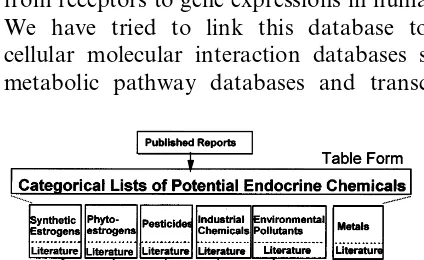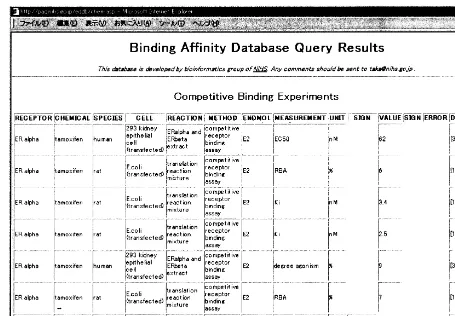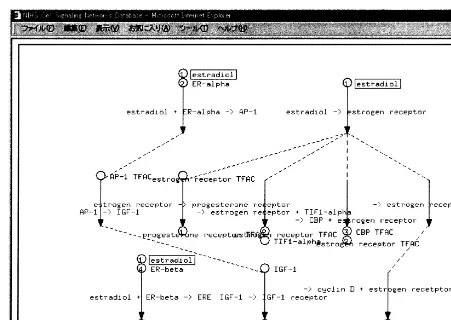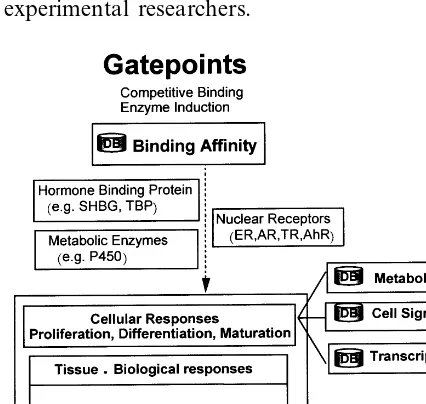Modeling of signaling pathways for endocrine disruptors
Tsuguchika Kaminuma *, Takako Takai-Igarashi, Tatsuya Nakano,
Kotoko Nakata
Di6ision of Chem-Bio Informatics,National Institute of Health Sciences,1-18-1,Kamiyoga,Setagaya-ku,Tokyo158-8501,Japan
Abstract
The so called endocrine disruptors have become an important working hypothesis for a wide range of toxicology researchers. This hypothesis has also attracted those who have worked on designer estrogens or selective estrogen receptor modulators. Already numbers of substances have been identified as such chemicals, but there remain a large number of chemicals waiting to be tested for their endocrine modulating capabilities. Because of the time and costs required for wet lab tests, it is unrealistic to apply these kinds of tests to all such suspicious or probable chemicals. Thus some theoretical methods must be developed for this purpose. However the conventional QSAR (quantitative structure activity relationships) approach is of limited relevance to this problem, because these methods do not take detailed mechanisms of molecular interactions in biological systems into account. Thus we have developed a database complex system that enables one to trace molecular interactions triggered by interaction of receptors with xenobiotic chemicals. The main components of this database complex are a potential endocrine disruptor database, a receptor database, a cell signaling networks database, a transcription factor database, and an affinity binding database based on modes of actions. © 2000 Elsevier Science Ireland Ltd. All rights reserved.
Keywords:Endocrine disruptor; Database integration; Computer-based screening
www.elsevier.com/locate/biosystems
1. Introduction
Recently the potential hazardous effects that estrogen-like and androgen-like chemicals and other environmental hormone-like chemicals may have on wildlife and human health have attracted much attention both the scientific community, particularly environmental toxicology, and the general public. A hypothesis has been proposed by several researchers that these chemicals mimic
natural hormones and modulate endocrine sys-tems, Colborn et al. (1996). These chemicals are now called endocrine disruptors, endocrine dis-rupting chemicals, or endocrine modulators.
A large number of projects have been proposed to study this hypothesis, Crisp et al. (1998). These studies are focussed on (1) what is the mechanism by which the endocrine disruptors modulate nor-mal endocrine systems, and (2) among enormous number of existing chemicals how we can screen such endocrine disruptors efficiently. It is obvious that conventional toxicological tests using animals such as fish, rats, or mice are not suitable to screen out endocrine disruptors from the so called
* Corresponding author. Tel.:+81-3-37009540; fax:+ 81-3-37007592.
E-mail address:[email protected] (T. Kaminuma)
existing chemicals, because the number of the latter is of the order of one hundred thousands.
It is thus essential to develop some theoretical or computer-based approach to pre-screen this large number of chemicals and reduce its number so that conventional wet lab tests or the so called high through put screenings (HTPS) can be appli-cable (http://www.epa.gov/opptintr/opptendo/).
Some feasibility studies have been carried out from this viewpoint, but it was pointed out, that conventional QSAR (quantitative structure activ-ity relationships) methods are not sufficient for such purposes, Tattersfield et al. (1997). The rea-son is that the well known ligand receptor binding model is not enough to characterize the function of suspected chemicals. For example, two differ-ent ligands that bind to a same receptor may not result the same phenomena (endpoints). The effect of a ligand binds to a receptor differs at different tissues. Moreover these approaches do not con-sider the so called cross talk among different signaling pathways. Such phenomena can only be handled by taking the cellular signaling systems and gene expression mechanisms into explicit consideration.
We had already developed a cell signaling net-works database (CSNDB), Takai-Igarashi et al. (1998), Takai-Igarashi and Kaminuma (1999), which stores causal signal transduction networks from receptors to gene expressions in human cells. We have tried to link this database to other cellular molecular interaction databases such as metabolic pathway databases and transcription
factor databases like TRANSFAC, Heinemeyer et al. (1999). We have then extended our CSNDB to link it to other databases in order to describe signaling pathways from the binding site with external (exogenous) chemicals to the resultant phenomena of interests (endpoints) such as devel-opmental abnormalities, carcinogenesis, and other pathological effects. These bindings are gate-point(s) for the external signals in the biological systems.
In this paper we present the prototype of an integrated databases and knowledge-bases com-plex of chemical substances and of biomolecules that can describe internal signaling evoked by endocrine disruptors from gate-points to the endpoints.
2. Conceptual framework of the system
Fig. 1 shows the steps to produce lists of prob-able endocrine disruptors, related chemicals and reference chemicals. We first did a literature sur-vey of potential endocrine disruptors on different categories of chemicals that include synthetic es-trogens for medicine, phytoeses-trogens, pesticides, industrial chemicals, environmental pollutants, and metals and their compounds. We then made lists of the chemicals per category and add regula-tory and other relevant information (http:// www.nihs.go.jp/hse/endocrine-e/paradigm/paradig m.html).
From these preliminary lists of endocrine dis-ruptors a database was produced. This database has three dimensional structure data which is important for predicting chemical properties and QSAR.
For each of the potential endocrine disrupting chemicals the mode of action was surveyed, and their receptors were identified if possible. A molecular interaction (affinity binding) database that stores binding data of xenobiotic chemicals (ligands) and their target biomolecules (mainly receptors) has been developed. Those receptors or interacting biomolecules are the gate-points at which some signals will be evoked by these xeno-biotic chemicals. These chemical signals will be transmitted or amplified by cellular signaling
works, will transcribe mRNA, will produce a protein, and will eventually effect the organism. The effects may be gene mutation, cell death, cancer, abnormal development, organism lethal-ity, reproductive failure, etc. Such effects are called endpoints.
Our eventual goal is to develop a computer-based causal network system that enables one to trace the effect of exogenous endocrine disrupting chemicals on biological signaling systems at the cellular and organism levels. For that purpose we need complete a knowledge base and databases for bio-signaling systems. However at present such a network system is incomplete, for there only exists receptor databases, metabolic pathway databases, cell signaling pathway databases, tran-scription factor databases, etc independently. Among these we have developed a receptor data-base, Nakata et al. (1999), and cell signaling database, Igarashi et al. (1998), Takai-Igarashi and Kaminuma (1999), by ourselves. The emerging WWW technology allows us to link so far independent system into an integrated system complex. We thus started to link existing data-bases and knowledge data-bases into a complex system. The WWW technology has also made excellent software available on the Internet. Molecular viewing tools such as Rasmol, Bradley (1994), Chemscape (http://www.mdli.com/) or Weblab (http://www.msi.com/) were embedded into our systems.
3. Endocrine disruptor database
From the categorical lists of chemicals we have produced a database. This database includes such entries as chemical name, CAS registry numbers, synonyms, physicochemical properties, and two-dimensional and three-dimensional structural data. The three-dimensional data were obtained by ab initio molecular orbital (MO) calculation using a commercial software Gaussian 94 (http:// www.gaussian.com/). At present we have obtained optimized coordinates for 149 substances.
With appropriate viewing software we can gen-erate three-dimensional images of chemicals. The three dimensional data are also important for 3D
QSAR analysis such as CoMFA (http://
tripos.com/).
4. Receptor database
The receptor database (RDB), Nakata et al. (1999), contains biomolecules that are found to be receptors. The definition of receptors changes in time. We have applied a sort of common sense definition. The receptor database stores the biomolecule names, their genes and sequences, spices, ligand etc. An object-oriented database called ACEDB (a Caenorhabditis elegans data-base), Thierry-Mieg and Durbin (1992), was used as the database management system. ACEDB is a database management system developed for C.
elegans genome research. Necessary data were taken from internationally well known biological databases such as PIR, SwissProt, PDB, Gen-Bank, and GDB. The system provides various viewing tools. By such tools one can highlight amino acid sequences for functional regions, such as DNA binding sites, ligand binding sites, and transmembrane regions. Present RDB contains 634 receptors.
5. Binding affinity database
This database stores experimental data for
in-teraction of exogenous chemicals and
biomolecules. Endocrine disruptors stimulate target organisms in various modes of actions. We consider the three basic modes of actions in our model; (1) interaction with extracellular binding proteins, (2) interaction with enzyme systems that metabolize hormones, and (3) interaction with hormone receptors, Cheek et al. (1998). Best ex-amples are given by estrogen case.
and albumin. Affinities of estradiol and DES to the transport proteins are of a different in order of magnitudes.
Steroid hormones are synthesized from choles-terol by a series of lyase and cytochrome P450 reactions. Specific P450 isozymes convert proges-terone to 17b-estradiol. Other enzyme systems such as reductases and transferases are also in-volved in inactivation and elimination of steroids. However these enzyme systems metabolize estro-genic exogenous chemicals. Conversely xenobiotic estrogenic chemicals up-regulate P450 isozyme ex-pression which leads to increased metabolism of these substrates and endogenous steroids and thus modulates the endocrine system.
However the main mode of action of environ-mental estrogens, that is estrogenic xenobiotic chemicals, is interaction with estrogen receptors (ERs). Estrogen receptors have common structure with other hormone receptors such as androgen receptors (ARs) and thyroid hormone receptors (TRs). Together they are classified into nuclear receptors. There also exist at least two types of estrogen receptorsa andb. Affinities are different in different combination of ligands (hormonal chemicals) and their receptors. Another important endocrine disruptor, dioxin binds to a different receptor called aryl hydrocarbon receptor (AhR). The fourth probable mode of action is direct interaction with cell signaling pathways without mediated by receptor bindings. The result may increase calcium concentration, affect the sodium channel and calcium homeostasis, and activate some kinases. We excluded this last case and only collected the first three modes of action binding affinity data.
The prototype of this system has been imple-mented on a stand-alone PC using a database management system ACCESS and is presently available through the Internet (Fig. 2).
6. Ligand-receptor docking studies
With Endocrine Structural Database, Receptor Database and Binding Affinity Databases one can have fairly wide view on how xenobiotic en-docrine modulating chemicals interact with their
receptor molecules. The databases contain three dimensional structural data of the interacting molecules. Structures of the ligands are mostly obtained by theoretical (ab initio molecular or-bital) calculation, while receptor structures were obtained from X-ray crystallography analyses. These data are relevant for the so called ‘docking study’ and QSAR studies.
At present we are studying three typical cases: estrogen like chemicals and the estrogen recep-tors, dioxins which interact with Ah receprecep-tors,
and the interaction of hormone transport
proteins. For these studies we use various compu-tational tools such as ab initio MO methods, Discover/Insight II, etc. Fig. 3 shows the relation between binding affinity database and modeling studies.
7. Cell signaling networks database
We have developed a database, CSNDB, for modeling and analyzing the signaling pathways, Takai-Igarashi et al. (1998), Takai-Igarashi and Kaminuma (1999). Using CSNDB one can
re-trieve pathways connecting two arbitrary
molecules. In CSNDB, no pathways are pre-en-coded but only binary relationships are recorded in the database. So it is the user’s request that creates pathways. Pathways are subsets filtrated from the whole networks. This filtration is based on our consideration that any cellular responses can be subsets of networks selected in response to various external and internal conditions of the cells. This pathway representation enabled one to overcome the difficult problem that there are no consensus grouping of signaling pathways. In the case of metabolic pathways, we can easily refer to the consensus grouping, such as chlorophyll thesis, fatty acid desaturation, and tyrosine syn-thesis. This is one of major distinctions between cell signaling and metabolic pathways.
Fig. 2. A query result of the binding affinity database. One can get both numbers and their reference literature information.
with labels. Particularly from biological view-point, the cyclic graph corresponds to the feed-back regulation that is an important mechanism for balancing a whole system. Since the graph is produced as the hypertext, a clicking on a node or an arrow calls a database entry. The arrows are liked to entries of molecular interactions and the nodes are linked to entries of biological molecules. The entries of biological molecules contain struc-tural and functional information and linkages to the external resources such as GenBank and Swis-sProt through the Internet. In CSNDB, all the recorded information is abstracted from published articles that are annotated in every entry.
CSNDB consists of three modules; the database management system, the inference engine, and the automatic graph drawer. We use object-oriented database system ACEDB, Thierry-Mieg and
Durbin (1992), for the database management sys-tem, rule-based production system CLIPS, Riley et al. (1988), for the inference engine, and the
Fig. 4. Representation of signals from receptor binding to gene expression by cell signaling networks database.
Letovsky’s algorithm, Letovsky (1995) for the au-tomatic graph drawing. All the modules are inte-grated with the user interface developed in the programming language C. From the standpoint of the database management system, CSNDB is a novel application of object-oriented technology to biological modeling. From the standpoint of pro-duction system, CSNDB works as real biologist in inferring possible pathways using biological prin-ciples as rules. The inference engine of CSNDB is programmed in LISP syntax. It executes data-driven forwarded-chaining inference. It finds con-nections between binary relationships when a transmitter of a relationship and a receiver of an another relationship are identical. Automatic graph drawing made us free from manually draw-ing of graphs and enabled frequent updatdraw-ing (Fig. 4).
A great advance of CSNDB is the data-ex-change with the transcription database, TRANS-FAC, Heinemeyer et al. (1999). Obviously, many cellular signals induce some gene expressions that evoke second-phase cellular responses. The inte-gration of pathways in cellular signaling and
tran-scription regulations will cover whole the
regulatory pathways occurred in cells. For the linkage of two databases, we developed a transla-tion table linking both entries. Through mediatransla-tion of the table, one can obtain possibly up- or down-regulated gene expressions from cell signaling pathways.
The present CSNDB contains 1968
8. From gatepoint(s) to endpoints
Endpoints are the biological phenomena or simply makers by which researchers identify posi-tive effects of chemical agents. Since the mecha-nisms of endocrine modulation due to xenobiotic chemicals have not been totally understood, we do not exactly know proper endpoints. Neverthe-less wide varieties of endpoints were proposed by experimental researchers.
From purely theoretical viewpoint, it would be possible some day to identify signal pathways to the reactions of biological systems at molecular base. Of course cell – cell interactions also play very important roles here. However our current knowledge is far from such view points. We sim-ply take these pictures as conceptual frame for the future studies (Fig. 5).
9. Linkage of databases
All of our component databases share at least two common entries; a chemical substance name and a biological molecular name. We assume that chemical substances which we take into the data-bases have CAS registry numbers. We then cre-ated the index database which is nothing but a big relational table composed of name of chemicals and the databases contain them. Indexing with CAS registry numbers tends to be a standard method in integrating chemical databases. How-ever we need indexing of relationships of chemi-cals and biomolecules although such an index does not yet exist. This is the reason that we created this index database. We consider the index database is important, because it can bridge be-tween toxic chemicals and biological responses through the mediation of biological pathways.
Technically, each database has interface to WWW, and the interface (Common Gateway In-terface) program converts queries to WWW to queries to the database. This enables one to cross-search through the hyper-linked database by his client machine browser. Fig. 6 shows a sche-matic diagram of our hyper-linked database com-plex.
10. Discussion
The system we have implemented might not only be relevant for predicting cellular responses to exogenous hormonal chemicals but also be useful for designing drugs that interact or control endocrine systems. The good examples of such drugs, designer estrogens, are two new anti-cancer drugs tamoxifen and raloxifene, Jordan (1998).
Fig. 5. Representation of causal pathways from gatepoint(s) to endpoints. Only cellular pathways are under construction.
Since expertise of cellular and organism signal-ing pathways and various assay data for en-docrine disrupting chemicals will rapidly be accumulated in the near future, we can easily increase and refine data and knowledge contents of our databases. Our complex system has enough framework and flexibility to add rapidly growing new experimental facts. Our complex system is also very flexible for adding new molecular
data-bases either on xenobiotic chemicals or
biomolecules.
Current lack of knowledge on signal pathway at organism level and the fact that many assay experiments are still on going make it difficult to develop reliable computer system to predict or-ganism reaction to endocrine disrupting chemicals at organism level. Our current system is only relevant to predict cellular response to exogenous hormones. Predicting higher level responses that are characteristic to multi-cellular organisms such as cancer or reproductive abnormalities are our next targets. The so called endpoints relate to these levels of responses. However we need some models which explicitly take cell – cell interactions into account. As a new approach we have pro-posed a more realistic modeling of bio-system called three-world model, Kanimuma et al. (1998). To combine the complex system intro-duced in this paper with the three-world model system is the next target of our studies.
11. Conclusion
The so called endocrine disruptors or endocrine disrupting (modulating) chemicals have become a very important working hypothesis for wide range of toxicological research. They are also important for drug design particularly designer estrogens such as tamoxifen and raloxifene.
We have developed data and knowledge base complex for endocrine receptors in order to sup-port experimental endocrine disruptor research. The main components of this database complex are a potential endocrine disruptor database, a receptor database, a cell signaling networks data-base, a transcription factor datadata-base, and affinity binding database based on modes of actions. The
index database and WWW technology link these databases. This complex system provides in-frastructure for describing cellular and organism responds to xenobiotic hormone-like chemicals in terms of signaling pathways. Such an infrastruc-ture is complementary to conventional QSAR ap-proach for theoretically predicting biological responses to endocrine disruptors. Only compo-nent (modular) systems are now available on the Internet (http://impact.nihs.go.jp/RDB.html, http://geo.nihs.go.jp/csndb.html, http:// hse.nihs.go.jp/eddb/afdb.html). The full prototype system will soon be put on the Internet.
Acknowledgements
We thank Drs Miyako Yamamoto and
Michiko Yamamoto, C. Ohtake, S. Hasegawa, H. Taki, and M. Yukawa for making heavy literature survey and listing potential endocrine disruptors. We also thank to Dr K. Koyano who carried out
molecular modeling calculations for these
chemicals.
References
Bradley, J., 1994. RasMol (ftp://ftp.dcs.ed.ac.uk/rasmol). Cheek, A.O., Vonier, P.M., Oberdoerster, E., Burow, B.C.,
McLachlan, J.A., 1998. Environmental signaling: a biolog-ical context for endocrine disruption. Environ. Health Per-spect. 106 (Suppl. 1), 5 – 10.
Colborn, T., Dumanoski, D., Myers, J.P., 1996. Our Stolen Future. A Dutton Book, New York.
Crisp, T.M., Clegg, E.D, Cooper, R.L., Wood, W.P., Ander-son, D.G., Baetcke, K.P., et al., 1998. Environmental endocrine disruption: an effects assessment and analysis. Environ. Health Perspect. 106 (Suppl. 1), 11 – 56. Heinemeyer, T., Chen, X., Karas, H., Kel, A.E., Kel, O.V.,
Liebich, I., et al., 1999. Expanding the TRANSFAC data-base towards an expert system of regulatory molecular mechanisms. Nucleic Acids Res. 27, 318 – 322.
Jordan, V.C., 1998. Designer Estrogens. Sci. Am., 36 – 40. Kanimuma, T., Igarashi, T., Nakano, T, Miwa, J., 1998. A
computer system that links gene expression to spatial organization ofCaenorhabditis elegans. In: Holcombe, M., Paton, R. (Eds.), Information Processing in Cells and Tissues. Plenum Press, London, pp. 243 – 252.
Nakata, K., Takai, T., Kaminuma, T., 1999. Development of the receptor database: application to the endocrine disruptor problem. BIOINFORMATICS (in press).
Riley, G., Culbert, C., Savely, R., 1988. CLIPS: an expert system tool for training, development, and delivery. Intell. Syst. Rev. 1 (1).
Takai-Igarashi, T., Nadaoka, Y., Kaminuma, T., 1998. A database for cell signaling networks. J. Comp. Biol. 5, 747 – 754.
Takai-Igarashi, T., Kaminuma, T., 1999. A pathway finding
system for the cell signaling networks database. In Silico Biol. 1, 129 – 146.
Tattersfield, L., Matthiessen, P., Campbell, P., Grandy, N., Laenge, R., 1997. SETAC-Europe/OECD/EC Expert, Workshop on Endocrine Modulators and Wildfire: Assess-ment and Testing (EMWAT), SETAC-Europe, Brussels. Thierry-Mieg, J., Durbin, R., 1992. Users’ Guide, Installation
Guide, Configuration Guide and Syntactic Definitions for the ACEDB Data Base Manager. All are included with ACEDB.



